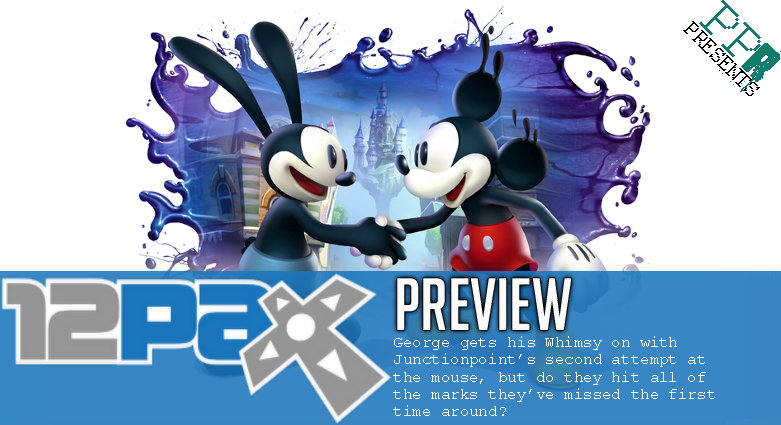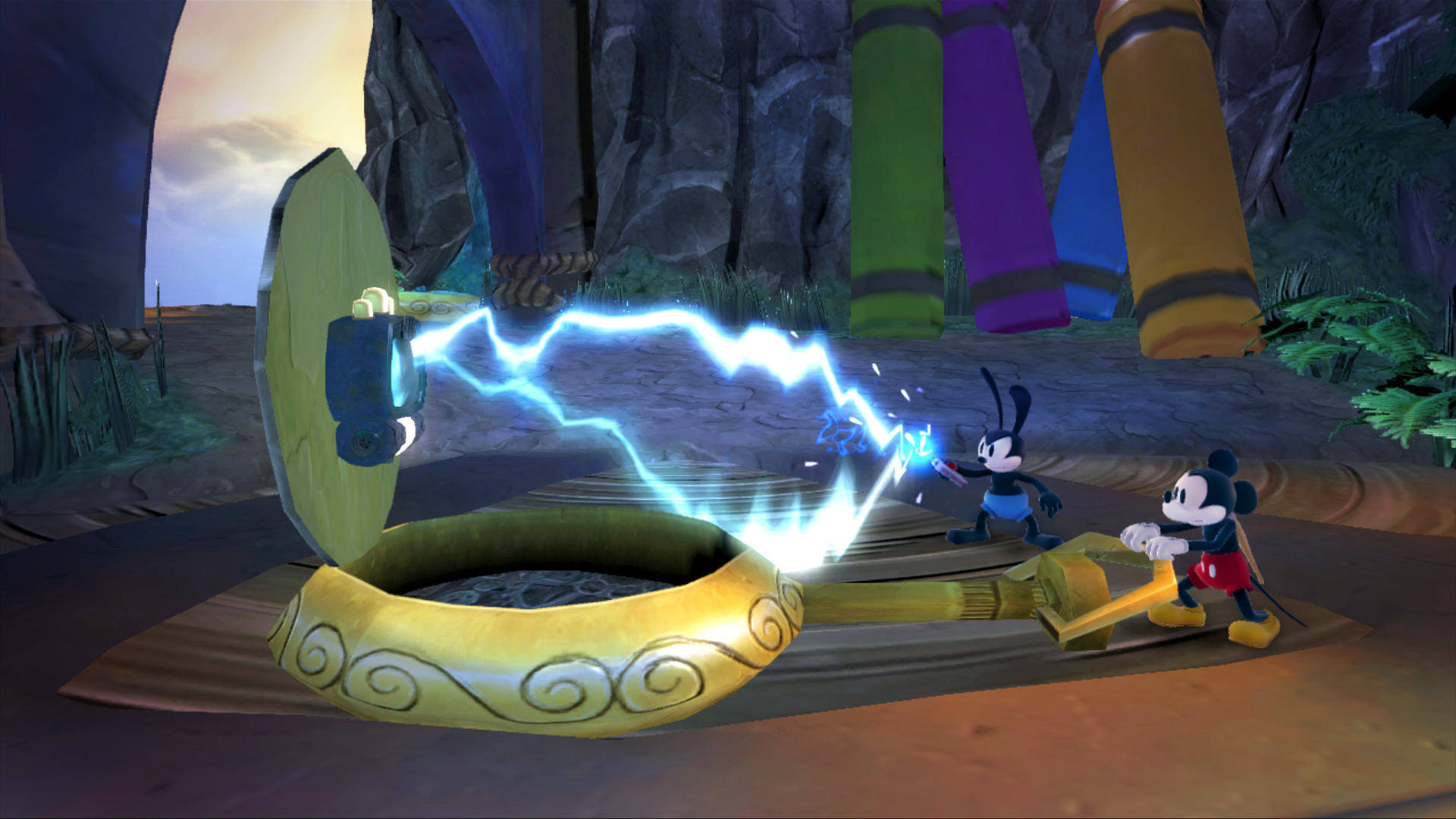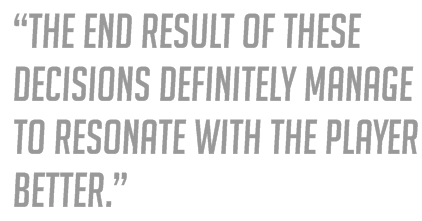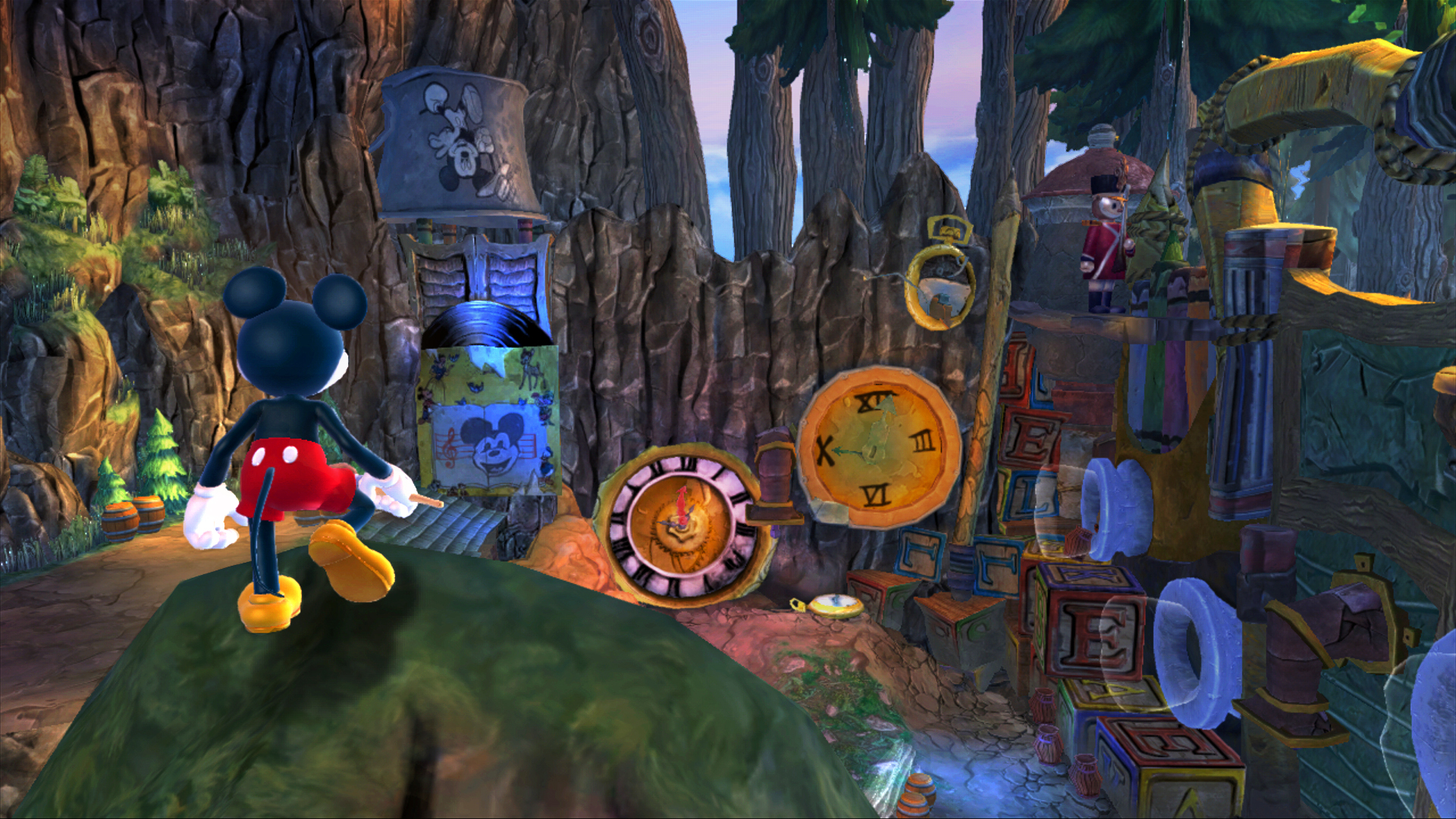PAX Prime 2012: Epic Mickey 2: The Power of Two Preview

Junctionpoint is at it once again, with work going towards the sequel for the 2010’s Epic Mickey. While its predecessor was criticized for a faulty control scheme and archaic platform mechanics, the studio claims they acknowledged these shortcomings and capitalized on what worked and the addition of drop-in/drop-out cooperative play with Epic Mickey 2: The Power of Two. Hands-on impressions of current build are… mixed.
Players return to Wasteland, an area that Mickey’s mischief was responsible for tampering with magic beyond his comprehension in Yen Sid’s lair. Mickey must return to Wasteland after retrieving the brush. Upon entering the wasteland, Mickey is immediately greeted and paired with his once reluctant and presently supportive comrade, Oswald the Lucky Rabbit. The build centered around an area influenced by one of the more obscure and yet popular in its right rides from Disney’s list of locales, Frontier land, simply introduced as the Fort for Wasteland. At first sight the elements for the presentation range from ingeniously subtle to whimsically obvious, with the nuances of smaller mouse heads spread across the land in secret in the vein of the Epcot center, the idle animation of Oswald removing his leg completely from his body and kissing his foot, and even more characters returning from the near endless roster of Disney’s past.

First thing’s first, the camera -- it’s fixed, for the most part. The nice touch behind Epic Mickey 2 is the variety of available play styles for the format you’re playing it on, and the controller layout for the right stick camera control actually works. Using the option to center the reticle for paint shots in the middle having the camera follow will definitely relate for anyone who’s familiar with third-person shooting and free aim also has its merits, and will move the camera view in the direction the reticle is heading towards. The least intuitive of the bunch is surprisingly The PlayStation Move style. Using the free-aim style by default feels stiff in contrast to the dual stick, and the camera movement doesn’t correlate to the same angling of the reticle movement in contrast to the controller counterparts. But overall, camera control is polished and far better than simply being bearable.
The cooperative mechanic is a bit of a mixed bag. When playing single player, Oswald constantly shadows you and boasts specific abilities of his own that you must utilize in order to progress. Oswald takes control or operates anything electronic that you encounter, and also possesses team abilities ranging from being thrown up into the air to Mickey tossing Oswald himself while jumping up to grab his feet as they glide across specific areas through the use of Oswald’s helicopter ears. The cooperative elements and its execution are reminiscent to that of Sonic The Hedgehog’s dynamic for Tails. Though the role of Oswald is much more integral for gameplay, its execution in terms of A.I. control is fairly poor in terms of contextual presentation. Moments involving the obligatory assistance from Oswald within the stage will cause you to wrestle with Oswald while properly directing himself to activate whatever stage mechanism he needs to serve his purpose for, and will jump in the air like an idiot for a lead up to cooperative move that has no bearing towards what you’re actually trying to accomplish. Unfortunately, this happens on more than one occasion.
Though the role of Oswald is much more integral for gameplay, its execution in terms of A.I. control is fairly poor in terms of contextual presentation. Moments involving the obligatory assistance from Oswald within the stage will cause you to wrestle with Oswald while properly directing himself to activate whatever stage mechanism he needs to serve his purpose for, and will jump in the air like an idiot for a lead up to cooperative move that has no bearing towards what you’re actually trying to accomplish. Unfortunately, this happens on more than one occasion.
The Platforming issues that were suffered from Epic Mickey unfortunately return in full force with Power of Two. The double jump mechanic helps make up for the “floaty” feelings, and the landing is always spotty upon re-entry from the air, even when you’re jumping onto flat surfaces resulting in a needless frustration for failed attempts jumping gaps accountable from faulty physics and not the player’s skill. The physical architecture and design of the stage are definitely improved; the concept intended for it lives up to the execution during play, and the lack of direction also being a concern from the original game has been address for this entry through the Gus the Gremlin acting as navigation point towards the area of stage to progress, making exploration a lot easier to swallow and fun even this time around. Despite the platforming aspects being hindered from the aforementioned issues, the availability of having several routes to reach one destination still allow for players meet their destined location to progress the stage but again alienate those who prefer platforming their way and will have to settle for taking an alternate route instead.

Combat has a nice sheen of polish as the attacks and paint shots naturally hit the mark detection from your aiming aliasing from the improved camera work. The sketch abilities return as well and prove to be much more useful, as they now have unlimited use with burn times in opposition to having a limited stock of use from the previous title. Dropping anvils or plopping down TVs when combatting mobs feels satisfying and varied over the alternative of just strafing and paint shooting. The ambiguous choice system returns and is more ambiguous than ever. Avoiding any association with a moral alignment, the choices are meant to be delegated from a much more pragmatic sense when making relations with characters or traversing the stage through use of paint or thinner, allowing the player to filling the moral blanks if they choose to do so and with choices appearing more often than with some even having permanent consequences, changing up your approach to a much more conclusive and deliberate one instead of just shooting paint and a thinner like a reckless madman. Characters can either stick with you throughout the entirety of the game or abandon you all based on your actions and the end result of these decisions definitely manage to resonate with the player better.
Overall, Epic Mickey 2 has the potential to be a great platformer with all of its innovative ideas in a generation where both platformer and ideas are few and far between. If more time in the oven can help iron out some of the more annoying issues plaguing the platforming and spotty interaction then it has the makings to be certifiable hit for Disney as an original license IP as it was first intended.
 Disney,
Disney,  PAX Prime 2012,
PAX Prime 2012,  Playstation Move,
Playstation Move,  platformer | in
platformer | in  Features
Features 









